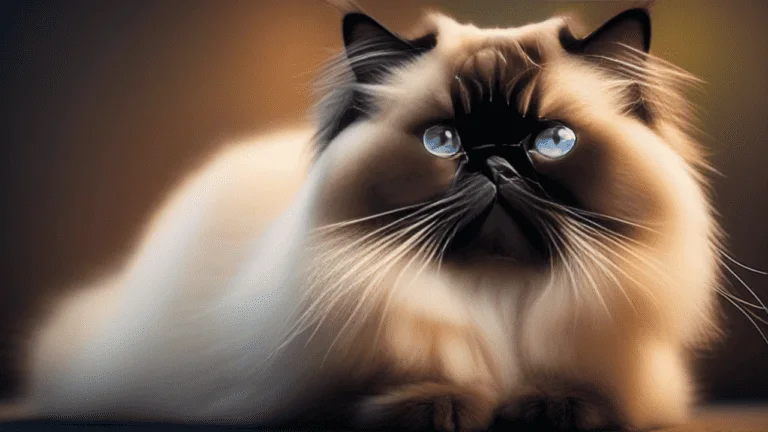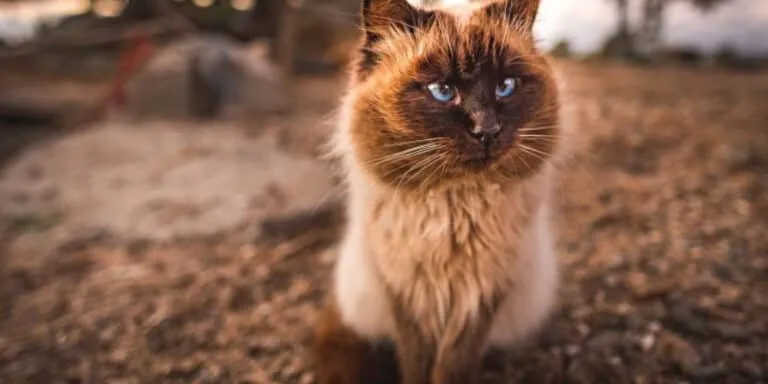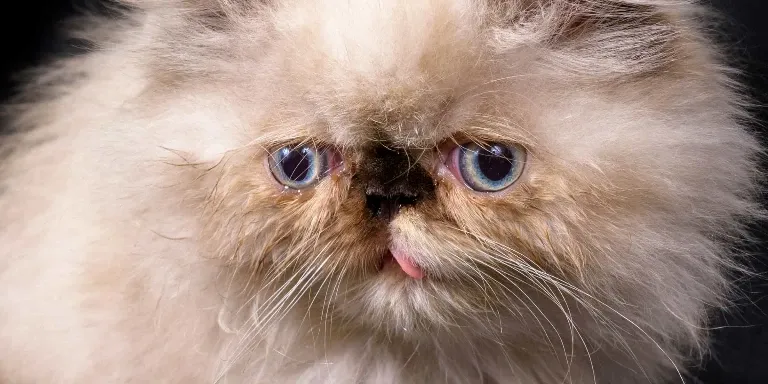The Best Fluffy Pancakes recipe you will fall in love with. Full of tips and tricks to help you make the best pancakes.

If you’re considering adopting a Himalayan cat, you’re in for a treat. These gorgeous cats are known for their stunning blue eyes, fluffy coats, and affectionate personalities. However, as with any pet, it’s important to understand their lifespan and how to help them live a long and healthy life. After all, you want to enjoy as many years as possible with your furry friend.
The lifespan of a Himalayan cat typically ranges from 9 to 15 years. However, with proper care and attention, they can live up to 20 years.
As the saying goes, ‘time flies when you’re having fun,’and the same can be said for the lifespan of a Himalayan cat. While many factors can affect their lifespan, including genetics and lifestyle, it’s important to have a general understanding of what to expect.
In this article, we’ll explore the typical lifespan of a Himalayan cat, common health issues they may face, and how to provide them with the best care possible. So let’s dive in and learn more about these beautiful cats and how to ensure they live a long and fulfilling life.
Brief Overview of the Himalayan Cat Breed
The Himalayan cat breed, known for its beautiful blue eyes and fluffy coat, has a lifespan of around 9 to 15 years, depending on various factors such as genetics and overall health. These cats are a cross between Siamese and Persian cats and are known for their affectionate and gentle nature. They are also quite social and love to be around their owners.
When it comes to grooming requirements, Himalayan cats need daily grooming to keep their coat in good condition. Their long hair is prone to matting and tangling, so regular brushing is a must.
In terms of personality traits, Himalayan cats are known for their calm and serene nature. They are not as active as other cat breeds and prefer to spend their time lounging around the house.
Overall, Himalayan cats make great pets for those seeking a loyal and affectionate feline companion.
Factors Affecting Lifespan
Factors like diet, exercise, and genetics can all impact how long a Himalayan feline can live. Environmental factors also play a significant role in a Himalayan cat’s lifespan. These factors include exposure to toxins, pollutants, and infectious diseases.
A healthy diet and regular exercise can help to extend a Himalayan cat’s lifespan. A diet rich in protein, essential fatty acids, and vitamins can help to maintain the cat’s overall health. Exercise helps to keep the cat fit and healthy, preventing obesity and related health problems.
Genetic factors also play a role in a Himalayan cat’s lifespan. Certain genetic traits can make a cat more susceptible to certain health conditions, which can reduce its lifespan. As a cat owner, it’s essential to be aware of these genetic factors and to take steps to manage them. By doing so, you can help your Himalayan cat live a long and healthy life.
Typical Lifespan of a Himalayan Cat
Usually, a Himalayan feline lives for around 9 to 15 years depending on various factors. However, some cats have been known to live up to 20 years or more.
The average age is influenced by several factors such as genetics, diet, exercise, and lifestyle. Proper care and attention can help increase the lifespan expectancy of a Himalayan cat.
Various health issues can affect the lifespan of a Himalayan cat, including kidney disease, respiratory problems, and dental issues. It’s essential to take your cat to regular check-ups with a veterinarian to identify any health problems early on.
Maintaining a healthy diet, providing regular exercise, and keeping your cat in a stress-free environment can also help to extend their lifespan. With proper care and attention, you can ensure that your Himalayan cat lives a long and healthy life.
How to Help Your Himalayan Cat Live a Long and Healthy Life
You can ensure your furry friend enjoys a lengthy and happy life by taking simple steps to maintain their overall health and wellbeing. Here are some nutrition tips and exercise routines that can help prolong your Himalayan cat’s lifespan:
- Provide a balanced and nutritious diet that’s appropriate for your cat’s age, activity level, and health condition. Avoid feeding your cat human food or any food that’s toxic to cats.
- Make sure your cat always has access to clean and fresh water. Dehydration can lead to various health problems, such as kidney disease and urinary tract infections.
- Encourage your cat to exercise regularly by providing toys, scratching posts, and climbing structures. Playtime not only helps burn off excess energy but also strengthens the bond between you and your cat.
- Schedule regular check-ups with your veterinarian to detect and treat any health issues early on. Preventive care is essential for maintaining your cat’s health and preventing serious illnesses.
By following these tips, you can help your Himalayan cat live a long and healthy life. Remember to always prioritize your cat’s wellbeing and provide them with the love and care they deserve.
Common Health Issues in Himalayan Cats
If you own a Himalayan feline, it’s important to be aware of the common health issues that they may face. Some of the most common health issues that Himalayan cats face are related to their eyes and respiratory system. These cats have a flat face, which makes them more susceptible to respiratory issues, such as breathing difficulties and infections.
Additionally, they may develop eye problems, such as cataracts, glaucoma, and corneal ulcers. To help prevent these issues, it’s important to keep your Himalayan cat’s environment clean and free of irritants. You can also provide your cat with a high-quality diet that supports their immune system and helps them maintain a healthy weight.
Additionally, regular veterinary check-ups can help catch any potential health issues early on, allowing for prompt treatment. If your cat does develop any health issues, common treatments include antibiotics, eye drops, and surgery in more severe cases. By being aware of the common health issues that Himalayan cats face and taking preventative measures, you can help ensure that your furry friend lives a long and healthy life.
Early Detection and Treatment of Health Issues
As an owner of a Himalayan cat, it’s important to be aware of the signs and symptoms of common health issues in this breed. Early detection can prevent the progression of illnesses and potentially save your cat’s life. Treatment options may include medication, surgery, or lifestyle changes. It’s important to work closely with your veterinarian to determine the best course of action for your cat’s individual needs.
Signs to Look Out For
Keep an eye out for these signs that your Himalayan cat may be nearing the end of their lifespan.
First, changes in appetite and water intake can indicate underlying health issues such as kidney disease or diabetes. If your cat suddenly starts to lose weight or become dehydrated, it’s important to take them to the vet for a check-up.
Second, difficulty breathing or shortness of breath can be a sign of heart or lung problems. Himalayan cats are prone to respiratory issues, so it’s important to monitor their breathing patterns and seek veterinary care if you notice any changes.
Finally, lethargy or lack of energy can also be a sign of underlying health issues. If your cat is not as active as usual or seems to be sleeping more than usual, it’s important to take them to the vet for a check-up and to discuss preventive measures to keep them healthy.
Overall, it’s important to be aware of these signs and to seek veterinary care if you notice any changes in your Himalayan cat’s behavior or health. Preventive measures such as regular check-ups and vaccinations can help keep your cat healthy and extend their lifespan.
Treatment Options
When it comes to helping your furry companion in their final stage of life, there are various treatment options available. One of the most important things to consider is preventative measures, which can help to extend your Himalayan cat’s lifespan.
This includes regular check-ups and screenings, as well as a healthy diet and exercise routine. However, as your cat ages, they may require additional support through alternative therapies.
These can include acupuncture, massage, and even herbal supplements. It’s important to work with your veterinarian to determine the best course of action for your cat’s individual needs.
With the right care and attention, you can help your Himalayan cat live a long, happy life.
Understanding End of Life Care
As you approach the end of your Himalayan cat’s life, it’s important to understand the options for end-of-life care.
Palliative care is designed to keep your cat comfortable and pain-free during their final days. Euthanasia may be considered if your cat’s suffering is too great.
Coping with the loss of your beloved pet can be extremely difficult, but there are resources available to help you through this challenging time.
Palliative Care
Providing palliative care to a Himalayan cat during its final days is a crucial and compassionate way to ensure a peaceful end to its lifespan. Palliative care is a form of hospice services that aims to alleviate pain and discomfort for animals who are approaching the end of their lives.
Here are five important things to consider when providing palliative care for your Himalayan cat:
- Pain management: Pain is a common symptom in animals who are nearing the end of their lives. Regular pain assessments and the use of pain medication can help to keep your Himalayan cat comfortable.
- Nutrition: Providing adequate nutrition is important for maintaining your cat’s strength and energy levels. However, as cats near the end of their lives, they may experience a decrease in appetite. Feeding small, frequent meals and offering palatable foods can help to maintain their interest in eating.
- Hydration: Dehydration can cause discomfort and contribute to other health problems. Providing access to fresh water and encouraging your cat to drink regularly can help to prevent dehydration.
- Comfort: Making your cat’s environment as comfortable as possible is important during palliative care. Soft bedding, a quiet and peaceful space, and access to a litter box and familiar toys can help to reduce stress and increase comfort.
- Emotional support: Palliative care not only focuses on physical comfort but also on emotional support for your cat. Spending time with your cat, offering gentle affection, and engaging in activities they enjoy can help to provide comfort and improve their quality of life.
Overall, providing palliative care for a Himalayan cat during its final days can help to ensure a peaceful and comfortable end to their lifespan. By focusing on pain management, nutrition, hydration, comfort, and emotional support, you can help to improve your cat’s quality of life and make their final days as comfortable and dignified as possible.
Euthanasia
You may be faced with the difficult decision of whether or not to euthanize your beloved feline companion. This decision can be made after considering various factors, such as the severity of your cat’s medical condition, quality of life, and pain management options.
It’s important to consult with your veterinarian and discuss all possible treatment options before considering euthanasia. When it comes to ethical considerations, it’s crucial to ensure that euthanasia is done in a humane and compassionate manner.
Your veterinarian may administer a sedative to your cat before the euthanasia injection to minimize any pain or discomfort. It’s important to remember that euthanasia is a personal decision and should be made with careful consideration and consultation with your veterinarian.
Coping with Loss
Losing a furry family member can be an incredibly difficult and emotional experience, leaving a void in your home and heart. Coping with the loss of a Himalayan cat can be especially challenging because of the unique bond that these cats often form with their owners.
The grieving process is a natural and necessary part of healing, but it can be overwhelming and difficult to navigate alone. It’s important to reach out for support during this time. Consider joining a pet loss support group or seeking counseling from a professional who specializes in grief and loss.
Talking about your feelings with someone who understands the depth of your loss can be incredibly helpful in processing your emotions and finding healthy ways to cope. Remember that there’s no ‘right’ way to grieve, and it’s important to honor your own unique process.
With time and support, you will eventually be able to find peace and healing after the loss of your beloved Himalayan cat.
Do Himalayan Cats Also Display Obsessive Behavior Towards Their Owners?
Himalayan cats, like Siamese cats, can exhibit obsessive behavior towards their owners. This can include following their owners around, meowing for attention, and wanting to be close at all times. Understanding the Siamese cat obsession dynamics can also shed light on similar behavior in Himalayan cats.
Conclusion
Congratulations on learning about the lifespan of Himalayan cats! As you now know, the typical lifespan of these beautiful, fluffy felines can range from 9 to 15 years.
However, by taking good care of your Himalayan cat and being vigilant about their health, you can help them live a long and happy life.
Remember, just like any other living creature, Himalayan cats are affected by various factors that can impact their lifespan. These include genetics, diet, exercise, and environmental factors.
By providing your cat with a healthy diet, plenty of exercise, and a safe and comfortable home environment, you can help ensure that they thrive and enjoy a long and happy life.
Additionally, it’s important to stay on top of your Himalayan cat’s health by scheduling regular vet check-ups and keeping an eye out for common health issues. By catching potential health problems early and getting your cat the necessary treatment, you can help extend their lifespan and ensure that they enjoy their golden years to the fullest.
Remember, your Himalayan cat is a special and beloved member of your family, and by taking good care of them, you can help them live a long and healthy life.








